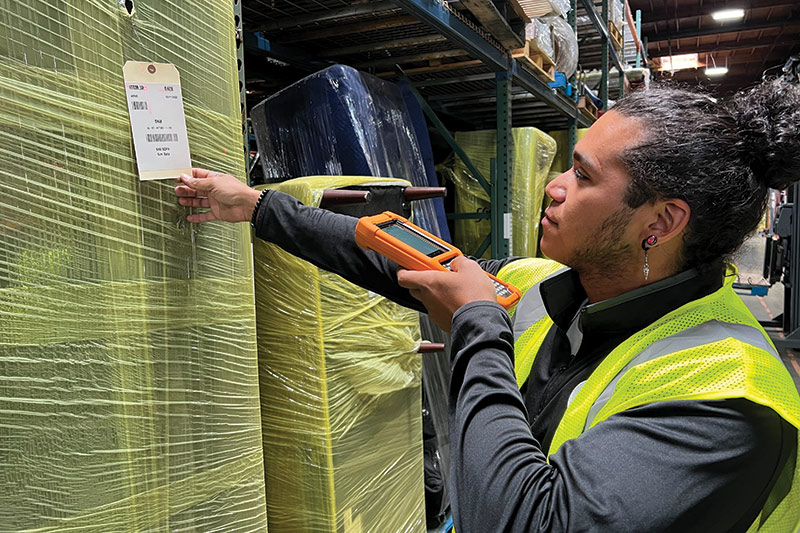Rapid WMS rollout fits functional needs
Furniture e-tailer Oliver Space deploys Cloud WMS in less than two months while meeting its unique needs around inventory tracking and visibility over a reverse stream of goods being refurbished for its home furniture lineup.
A successful and rapid rollout of a warehouse management system (WMS) is an achievement for any company, since WMS acts as the backbone system for inventory control, as well as management of receiving, storage, picking, packing and shipping tasks for fulfillment operations.
For rapidly expanding furniture e-tailer Oliver Space, the WMS deployment was fairly quick, and it met some unique needs around the tracking and management of a reverse stream of goods coming into the facility. Oliver Space delivers and assembles its premium new furniture as part of order fulfillment to its customers, but it also picks up and refurbishes used Oliver items to be made available at discounted prices.
This circular economy approach to furniture retailing does call for careful warehouse-level assessment, refurbishment status tracking and inventory control over these goods. The approach offers consumers a means of obtaining high-quality furniture at a discount. As this part of the business grew, Oliver Space’s warehouse processes struggled with inventory accuracy and real-time visibility into refurbishment status, which lead it to explore WMS options and select a Cloud-based WMS solution (Synergy).
The SnapFulfil WMS was deployed in six weeks, going live in May 2022. According to David Guckian, product manager at Oliver Space, the deployment time frame included integration to the company’s custom-developed enterprise resource planning (ERP), testing of the WMS and the ERP integration, user training, as well as some customization of inventory codes.
Ease of customization was important to Oliver Space, says Guckian, because for refurbished inventory, it needed a WMS that could record different inventory condition classifications as goods were received (the company tracks three grades—like new, very good and age-worn), manage location and status of all goods in the WMS, and update the ERP system at key steps to support accurate order promising for the refurbished goods on Oliver Space’s website and e-commerce platform.

“What we needed from a WMS was a way to have a clear visibility within our warehouse, of where exactly these refurbished items are, and what condition they’re in, as we triage and manage these goods,” says Guckian.
To support this real-time tracking over refurbished goods, Oliver Space uses bar codes that act as identifiers for each refurbishment grade and wireless data collection processes that tie into the WMS. This allows tracking of each item at the parent SKU and child/condition level, says Guckian, with timely inventory status reconciliation to the ERP. If Oliver Space staff decides it makes sense to do some extra refurbishment to an item to bring it up a classification, another bar code scan updates the changed status.
This configurability of the WMS along with the bar coding procedures using rugged RF mobile devices (Honeywell) and bar code printers (Zebra Technologies) has given Oliver Space near real-time control over refurbished inventory classifications, locations and any change in status.
“We can now separate out, both in the system and the warehouse itself, all the different levels of stock and returns, which immediately optimized our inventory management capacity,” Guckian says.
Along with the new WMS, business growth also prompted Oliver Space to transition from its previous 18,000-square-foot warehouse to a new 30,000 square foot facility in San Francisco, Calif. Within this fulfillment center, the WMS manages the full range of processes for new furniture and refurbished, including inventory control, and pick, pack and ship tasks.
During the WMS deployment, the integration with the ERP was fine-tuned to minimize latency, says Guckian, but configuring the WMS to track classification codes on refurbished goods was not hard to accomplish using the configuration tools within the WMS.

“We looked at the full range of WMS solutions available, but around our key requirement of customization, the top-tier systems were too labor intensive and costly to justify implementing,” he says. “We treated it as a proof of concept and SnapFulfil quickly became the provider of choice because of their ability to work with us and facilitate all the process quirks and anomalies we required for a niche and complex business operation.”
The Oliver Space implementation was handled remotely. This included testing application programming interfaces (APIs) to the ERP and running live operations concurrently with legacy warehouse management functions in the ERP until full deployment.
“When we were ready to go live it all went to plan and was like flicking a switch because of all the joint preparatory work we’d put in,” Guckian says.













